 Mrs. Homegrown, justifiably, gives me a hard time for growing strange things around the homestead. This week I just completed the world’s smallest harvest of a root vegetable popularly known as crosne (Stachys affinis). Crosne, also known as Chinese artichoke, chorogi, knotroot and artichoke betony is a member of the mint family that produces a tiny edible tuber. While looking like any other mint plant, the leaves have no smell. The tubers look all too much like the larval form of the Michelin tire mascot and have the taste and texture of a Jerusalem artichoke.
Mrs. Homegrown, justifiably, gives me a hard time for growing strange things around the homestead. This week I just completed the world’s smallest harvest of a root vegetable popularly known as crosne (Stachys affinis). Crosne, also known as Chinese artichoke, chorogi, knotroot and artichoke betony is a member of the mint family that produces a tiny edible tuber. While looking like any other mint plant, the leaves have no smell. The tubers look all too much like the larval form of the Michelin tire mascot and have the taste and texture of a Jerusalem artichoke.
I got the tubers, that I planted last year, from Alex Weiser of Weiser Family Farms, who always has an amazing booth full of produce at the Hollywood farmer’s market. I asked Alex if he thought I could grow them here in Los Angeles. He said that he wasn’t sure, but that he thought that where he grew crosne, at a higher altitude with a much colder winter, would be more conducive to producing a good crop of tubers.
Undaunted, I planted two self irrigating planters made from storage bins with about twelve or so tubers. Throughout the year the foliage was lush and finally died back in late November. It was really easy to grow, just like any other mint. It grew to about 1 1/2 feet and never produced flowers. I’m sure in wetter places it would be invasive. I spoke to Alex at the market again in December and he told me to pull the tubers out around Christmas. Alex was right, I didn’t get a very big crop–LA is probably not the best climate for this plant. No crosne banquet this winter. But I did get enough to make a jar of pickles with.
 I feared that it would be as hard to clean as Jerusalem artichoke, but a few blasts of the garden hose took off most of the dirt. French folks cook crosne in butter. I decided to pickle them in white vinegar using a recipe for Jerusalem artichoke. The recipe I used was a little too heavy on the mustard, otherwise I’d pass it on. The addition of some tumeric gave the pickles an appealing yellow color. I’ve been tossing them into salads to the horror of Mrs. Homegrown, who is not a fan of my crosne pickles.
I feared that it would be as hard to clean as Jerusalem artichoke, but a few blasts of the garden hose took off most of the dirt. French folks cook crosne in butter. I decided to pickle them in white vinegar using a recipe for Jerusalem artichoke. The recipe I used was a little too heavy on the mustard, otherwise I’d pass it on. The addition of some tumeric gave the pickles an appealing yellow color. I’ve been tossing them into salads to the horror of Mrs. Homegrown, who is not a fan of my crosne pickles.
Eric Toensmeier, author of Perrenial Vegetables has a YouTube tour of his garden where you can see how he grows crosne. Toensmeier interplants it with other root crops that mature at the same time, so you get a mix of things at harvest.
The Plants for a Future entry on Stachys affinis has some nice information on how to grow it.




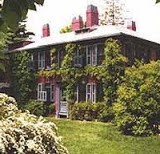
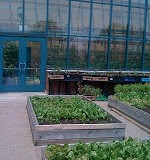
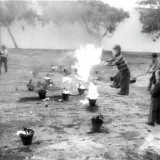
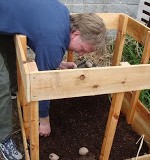
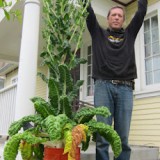
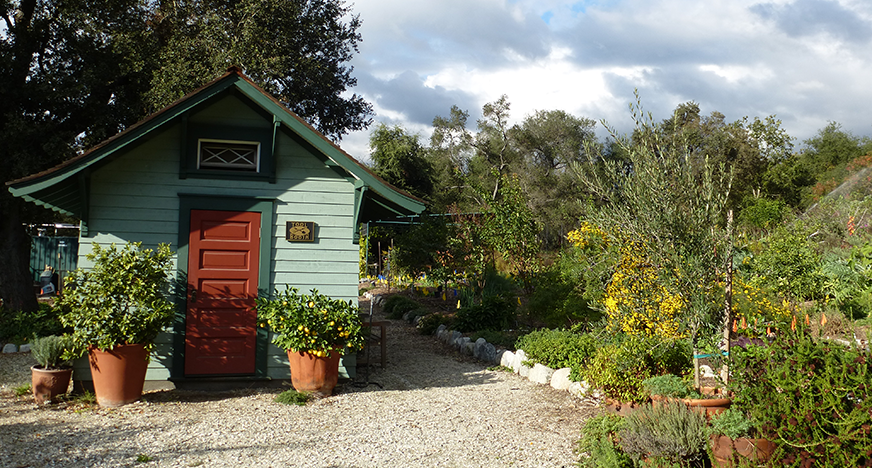
And it makes a perfect addition to a Halloween party. Let’s have some delicious larvae on toast!
Yes, Ragnar. They are an amazingly fun, creepy food. Kids would adore them because they’re not only gross looking, but they are also crunchy and mild tasting. They’d be worth growing just for Halloween extravaganzas.
My principle beef with them was just that they are not suited to the the LA climate, so they took up lots of grow space and water for the better part of a year and in the end yielded 2 cups’ worth of novelty food. We won’t grow them again, but if we lived somewhere wetter and colder and more spacious, I think it might be fun to let them grow wild.
The best way to pickle them would be in brine, imo, to bring out their delicate flavor. Mr. Homegrown’s screaming yellow worm pickles are…er…boldly and uniquely spiced.
just bought your book, and was reading some reviews on Facebook, which led me here. and the first post i read, OMG, i have been trying to get rid of this plant in my front yard for almost 10 years. looking at the pictures of the leaves and the tubers, i’m almost 100% certain that’s what it is. it is invasive in my yard, and i live in east central Alabama.
i will explore this further, and if it is indeed crosne, will let them stay, to harvest.
I’ve been wanting to dig up and eat a North Floridian version of this plant, Stachys floridana, the Florida betony. They produce better tubers in sandier soils (which is pretty much all the natural soil is–sand). The ones in my garden aren’t putting down tubers as much as popping up rhizomously all over the place.
Reader Joseph, I read somewhere that what you’ve got came from Florida. But they’re really very similar, so proceed with that harvest.
Kelly and Joseph–report back on what you find. Stachys floridana looks promising.
An article in Motherearth news says that cropping or shearing when a foot high to six inches creates larger roots, and never let them flower.
I think I’m with Mrs. Homegrown here…that is a shockingly unattractive jar of pickles! It sounds like a fun experiment, though.
HE, unfortunately I won’t be of much service in this area, as I have to leave for the spring term at school, which is in Chicago. Yet another reason to appreciate graduation–I’ll be able to stay with my land for full seasonal cycles.
those are interesting little things! So they really taste good?
I thought I knew root veg – guess not…those look CRAZY!
@Lisa P:
They are crunchy and mild, very much like sunchokes aka Jerusalem artichokes. If you haven’t had those, then just think vaguely sweet, vaguely nutty.
used to eat those growing up in Florida… they grew wild and tasted just a little sweet and had a nice crunch like cucumber or water chestnut. not starchy as I recall. cool…
If you like Jerusalem Artichoke/Topinambur, you should definitely go for it, we had a massive harvest and you can leave it in the soil till the ground freezes (if it ever does at yours) for storage. And it looks like a sunflower, so it is pretty as well. Ours needed some support later on, they grow 8 feet tall and more and the autumn storms played them a little, but even if torn to the ground the actual Choke grows on. It is almost impossible to get them all out of the soil, so there is your next years lot already.
A friend of mine sent me this link. I have a gallery of Sunchokes pictures that I took during the entire season. Go to: http://www.Sunchoke.Org
or the direct link is – http://www.sunchoke.org/gallery/season/sunchokeseason.html
There are 91 photos from beginning to end!
We actually dug some up today here in Michigan. It was 35 degrees but they came up pretty easy. The do keep growing after the stalk dies or is cut down.
Enjoy!
Hi from Paula….Speaking of eating creepy-looking things, I’m curious if you have investigated the insect-eating movement? Like “Girl Meets Bug”
The locals call Florida betony rattlesnake weed because the tubers look like rattles and they are truly a weed, impossible to eradicate, at least they were before I knew I could eat them.
wow! I can acutally eat these. I have so many of them growing in my yard and I am constantly pulling them up and to think I could have put those in my salad. I will definitely have to try them now. Can’t beat them, might as well eat them. Thanks everyone.
does anyone here know where to find plants for me to try to grow? I’m having a tough time finding them…
Try the Mother Earth News seed/plant search engine:
http://www.motherearthnews.com/find-seeds-plants.aspx
Found some here:
http://www.goodwincreekgardens.com/
Betony is one of my favorite “winter” plants here in Houston. Besides being apleasent munch, it was once considered an herbal “magic bullet” capable of curing all sorts of ills back in the Middle Ages. Since then it has fallen out of use for some reason.
http://houstonwildedibles.blogspot.com/2008/08/betony.html
So glad to see someone else knows about this! Our City of Jacksonville Parks gives a workshop on edibles in the wild and the betony was one of the items introduced. Kinda like a mild radish … my kids love to dig it up from the garden (and I welcome the labor).